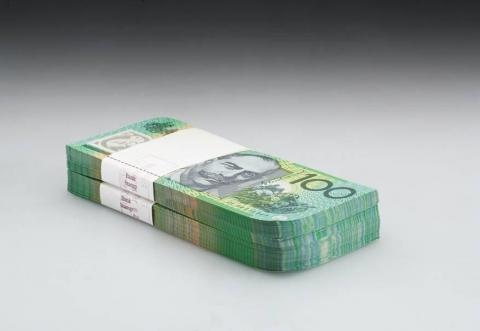CURRENCY, 2011
DENIS BEAUBOIS
two sections of uncirculated $100 Australian banknotes
100 banknotes in each section
6.5 x 15.8 x 1.2 cm each section
Section 1:
CE 08 214 456 - CE 08 214 461
CE 08 214 463 - CE 08 214 464
CE 08 214 466 - CE 08 214 467
CE 08 214 469 - CE 08 214 490
CE 08 214 492 - CE 08 214 494
CE 08 214 496
CE 08 214 498 - CE 08 214 499
CE 08 213 501 - CE 08 213 502
CE 08 213 504 - CE 08 213 508
CE 08 213 510 - CE 08 213 515
CE 08 213 517 - CE 08 213 534
CE 08 213 536 - CE 08 213 550
CE 08 213 552 - CE 08 213 567
Section 2:
CE 08 213 671 - CE 08 213 687
CE 08 213 689 - CE 08 213 708
CE 08 213 710 - CE 08 213 713
CE 08 213 715 - CE 08 213 716
CE 08 213 718 - CE 08 213 725
CE 08 213 727 - CE 08 213 740
CE 08 213 742 - CE 08 213 745
CE 08 213 747 - CE 08 213 766
CE 08 213 768 - CE 08 213 777
CE 08 213 779
Currency is a conceptual art project by Sydney artist, Denis Beaubois that explores the tension between the economic value of the material against the cultural value of the art object.
The artist states, “Twenty thousand dollars, consisting of uncirculated $100 notes, is presented as a sculptural object for auction. The material for the work has been sourced from a “New Work – Established” grant from the Visual Arts and Craft section of the Australia Council for the Arts. All currency used in the creation of the work has not been altered or modified and retains its potential function and value as legal tender. Furthermore, the serial number of each note has been recorded, to validate it as an authentic part of the artwork, thereby instilling a cultural value alongside the financial value of the object.”
This project and its process raises fascinating questions: What is the role of contemporary art? Is its success all about the money? Is its value in the ideas it generates, or just in the materials used? One of the most often used words in conversation about contemporary art is 'challenging'. Is contemporary art then at its best when it oversteps its boundaries?
Currency, poses fundamental questions about value and values. These questions are not so new: artists have been posing them for generations. In the twentieth century we have seen the ‘readymades’ by Marcel Duchamp, the use of non-art materials in Arte Povera, Campbell's Soup cans as ‘high art’ via Andy Warhol, or Jasper Johns’ Painted Bronze of the 1960s where the artist disguises the high art material of bronze by painting it to give the illusion of a humble coffee tin full of used paint brushes.
Simply, the value of an art object is subjective and often it greatly exceeds its material value. Yet, the face value of currency tends to decline with time and inflation, unless of course the banknotes gain 'collector value’ in the world of numismatics, or become 'collectable in the art market.
An assemblage of cash certainly presses the point. Damien Hirst's, For The Love of God, a diamond encrusted human skull which recently had a price tag of £50 million, is on a similar track, although it does represent a more obvious 'art object’ and its cost price, an estimated £10 million in materials, has been embellished by an organisation of the diamonds and skull in a creative act by a famous artist.
In the case of Currency, Beaubois is arguably being even more direct. When these uncirculated notes, in two sections or bricks, straight from a teller at the Reserve Bank of Australia are assembled as an art object, they become more than the sum of their parts... or do they? As an 'object of virtue', the pile of cash certainly has a presence! To some it is the embodiment of desire; to others it may have negative connotations. Is it freedom and possibility, or is it cold, hard cash, or is it filthy lucre? Indeed, apart from the odd appearance on TV in news stories about crime, how often does one actually see $20,000 in cash? Twenty Large looks surprisingly small but, to many in Australia and overseas, it is a life-altering amount of cash.
Denis Beaubois and Deutscher and Hackett have certainly questioned many features of this project. Aspects of Arts Law such as Moral Rights, which protect artists from someone, including the owner, defacing or destroying their work, (although in this case it is important to the artist that the new owners should be entitled to and may choose to ‘break it up’ and spend the cash) or the recently introduced Artists’ Resale Royalty, adds complexity to the presentation and sale.
Exchange rates, commodity prices, art investment, government arts funding, markets, values and the list of topics raised goes on. With the simplest of gestures, Beaubois has presented a work which is laden with potential and paradoxes.
DAMIAN HACKETT
